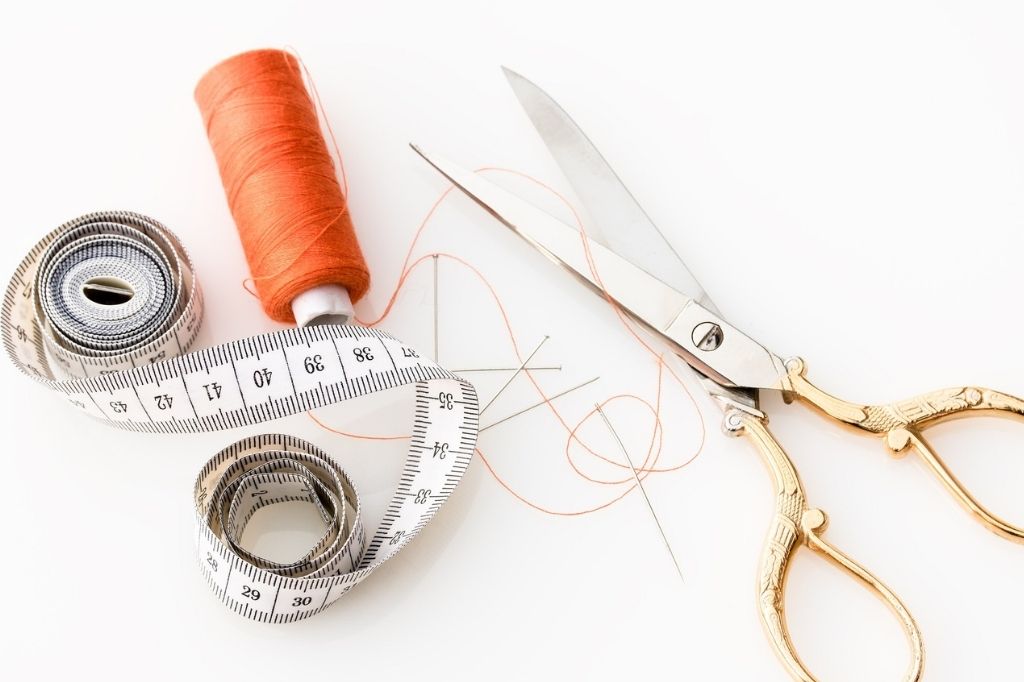Extend the Life of Your Clothes with these Easy D.I.Y. Fixes
It can be intimidating the first time you decide to try and repair your own clothes, but don’t let that stop you! Remember if it needs a repair then it’s already broken – you can’t make it too much worse.
(Unless you break out the scissors).
If you’ve been wanting to give mending a try here are three ways to mend clothes that are perfect for beginners.
Sewing on a Button
Arguably the most common repair needed for clothing reattaching a button is a lot less complicated than it looks!
Material: a needle, thread, and a button
First, figure out where the button needs to go. The easiest way to do that is by using a pen to mark through the center of the buttonhole.
Thread your needle, tying a knot at the end, and pass your needle from front to back through the mark you made. Next pass the needle back to front as close to that same point as possible and thread your button onto the needle.

Your button is now perfectly placed and your knot is hidden beneath it!
Repeat the process of running your needle from front to back, back to front, and through the button until the button is secure. You want it to feel snug against the fabric but not so tight that you won’t be able to button it.
On your last pass of the needle from back to front instead of going up through the button hold the thread taut beneath the button and wrap it around your earlier stitches 4-5 times.

Now pass the needle through the fabric, tie a knot at the back, and clip the excess tails.
You’ve successfully sewn on a button!
Repairing Rips
A rip is a hole where you can re-align the two sides of the fabric and they only need to be secured together.
By Hand
Material: a needle and thread
First, thread your needle and tie a knot at the end.
Start with your needle at the back of the fabric pulling it through to the front at either the top or the bottom of the rip.
Next, pass your needle from one side of the rip across to the other side and back through the fabric to the back. With your needle on the backside of the fabric pass your needle over to the other side of the rip and pass through to the front.
Think of it as a spiraling line around the rip pulling it together.

Repeat until you reach the bottom of the rip and tie off your thread on the backside.
You’ve successfully mended your rip!
By Machine
Material: a sewing machine and thread
To patch a rip by machine run your machine forward and backward across the rip from top to bottom. Once you’ve finished rotate your project 90 degrees and repeat.

This is a fairly invisible patch and very strong. It’s a great way to patch the crotch on pants or rips along seams.
You’ve successfully mended your rip!
Patching Holes
A hole is a rip where you can’t re-align the two sides of the fabric and need to add a patch to fill in the space.
By Hand
Material: a needle and thread
To make a patch start by cutting a piece of material into a square slightly larger than your hole and pinning it to the backside of your fabric.
Sew around the hole being sure to catch the patch material as you go. Once you’ve gone all the way around the hole you can flip your material inside out to trim off the excess patch fabric.

You can make patches nearly invisible by matching your patch material and thread to the material of what you’re mending.
(figure A)
Or you can make a visible mend by using mismatched patch material, or thread, or both! Sashiko mending uses thread to create patterns around the patch, usually using geometric designs.
(figure B)
Another visible mending method is to create a woven design across the top of the patch using embroidery thread. It can be done in any combination of colors – to match your original project or to create an eye-catching design.
(figure C)
You’ve successfully attached your patch!
By Machine
Material: a sewing machine and thread
Attaching a patch by machine is almost identical to mending a rip with a machine. Pin the patch under the hole from the back and then zig-zag your way from top to bottom and then from side to side.

This is a fast and sturdy way to patch a pair of pants. It isn’t the most exciting mending method but if you’re aiming for functional and fast then this is the way to go.
You’ve successfully attached your patch!
What do you think?
Have you tried mending your clothes before? Do you think you’ll try one of these methods?
Comment below and let me know!
If you’re interested in other ways to add some sustainability to your sewing practice check out my post 10 Tips for Sustainable Sewing








